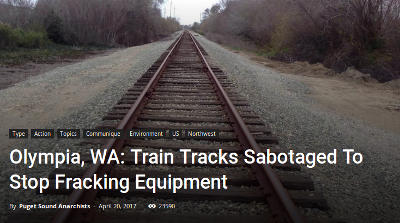By Emma “Usnea” Murphy-Ellis
Courtesy of EarthFirst! Journal

Ski lodge in Vail, Colorado set ablaze by ELF (Originally posted here)
I state without fear— but with the hope of rallying our collective courage—that I support radical actions. I support tools like industrial sabotage, monkey wrenching machinery and strategic arson. The Earth’s situation is dire. If other methods are not enough, we must not allow concerns about property rights to stop us from protecting the land, sea, and air. Today, more than ever, the Earth needs our effective action using all the methods of resistance at our disposal. Radical actions and radical movements grow out of supportive cultures. Let us once again build a strong supportive base for them.
Don’t get me wrong. During the Green Scare, in which dozens of activists were incarcerated, our movement got seriously screwed with, and we have had some extremely hard times because of the outstanding repression we have faced for the last six years. I want to remember that we were targeted by the powers that be because we were effective. Not only was EF! a growing force with which the state and corporations were fearful to reckon, but also that other more radical affinities were being forged in our communities.
To state it clearly, ELF actions came out of our communities and shared struggles.
The FBI knows that. Its been said in court by their officers. Its been written in their documents. Instead of shying away from that, let’s say it proudly. We already face major repression. Pretending that is not the case does nothing but mislead new folks and create more fear. Let me say it again: the majority of underground ecological actions that took place over the last decades grew out of our movements that were supportive of them. Our movements were the incubator.
Are you disheartened that there are less radical actions attacking the root causes of the ecological crisis? Me too. So let’s take one effective, tangible step towards changing that by openly celebrating all tools in the box. However, when celebrating, we should be mindful of practical lessons of security culture learned from the Green Scare. The best practical advice in celebrating sabotage is to publicly celebrate, but not to publicly incite. Inciting is illegal. For example, yelling, “The logging trucks are coming, everybody get into the road, block it, and then firebomb the fucker!” Not so smart.
But, it is not illegal, for example, to get excited around the camp fire, stand up, and read a particularly eloquent communiqué out loud while others clap, cheer, and celebrate how the bad guys got their asses kicked that round. It is not illegal to talk about how awesome the blockade and sabotage was (in the hilarious communiqué below, for example) and say proudly that you wish there were more like it. And, it should not be illegal to openly support and generally advocate the use of incendiary devices. But please note, there are no promises in love and eco-war; the state and its courts have proven over the years that if they want you bad enough, universal human rights of speech and expression may not matter. A friendly lawyer checked this part of this article out and agreed that the do’s and dont’s listed here are indeed the case.
With that all said, I propose that EF! gets back to openly and publicly celebrating radical, underground tactics, in our songs, our stories, our Journal, and on our T-shirts (anyone remember the one that read: I torched Vail, ask me why).
If there is a knock on your door by the agents of state repression (supposedly because of your undying, unabashed support of pouring abrasive compounds into gas tanks, loosening bolts that hold up power lines, or smashing computers at your local biotech facility.) So what. Yep, just more evidence, that we live in a police state. Let’s use that knock as a springboard to organize stronger and more effective resistance to state harassment.
And a quick note about security culture, because I feel like our movement has gotten way off track with that subject. Security culture is the building of awareness intended to keep one safe from repression. It is essentially a set of guidelines on how to live in an active resistance movement where individuals may or may not be breaking the law, and minimize risks of the state cracking down on us. It is not a bunch of paranoid random rituals or estranged superstitions, nor is it folks being alienating to new people or a way to act cool and superior. It is, in fact, a whole bunch of behaviors and, for lack of a better phrase, social protocols—which are always evolving—for how to behave in order to keep yourself, and everyone else you interact with, safer. It is something that should be done so fluidly that most of the time, others don’t even know you are doing it. And when eventually it is needed for you to “call someone out” you will do it in a way that makes them feel all the more welcomed and a part of a learning movement, as opposed to alienated and even more unsure as to how to act responsibly, right?
Perhaps the most damaging events from the Green Scare are behind us. But the brunt of the cleanup and lessons we still must learn lie ahead. The Green Scare cracked some of the foundations of our movement leaving us unstable and, in my opinion, in desperate need of shoring up.
One of the reasons I think our movement continues to get smaller and smaller is because we have, out of fear, limited and censored ourselves. Our support of radical direct action is one of the main things that made us unique. There are no other groups like us around; no other above ground ecological activist group that vocally supports, unabashedly and unapologetically, the use of every tool in the tool box to take down this fucked up system and hopefully save what little we have left, so that it can recover from the plague of industrial civilization. Long live the Earth Liberation Front!
Yours for the rev,
—USNEA (ALSO KNOWN AS EMMA “COME AND GET ME, FUCKERS” MURPHY-ELLIS)
P.S. Since it’s not illegal, I wanted to share some excerpts from a communiqué that was sent out on October 13, 2008, after the Canadian Pacific Railway sabotage took place.
Pass it along! Share it with friends!
Enjoy!
“In an attempt to cause a shitload of economic damage to the infrastructure of the CP rail main-line, we cut down two telephone poles across the tracks just to the north of their main intermodal yard outside Toronto. A pile of fallen trees was ignited with gasoline across the tracks, and we molotov’d one of those weird grey box things that look pretty important and are full of electrical shit. We also tied copper wire across the tracks to signal the blockage so no one would get hurt. That was way more exciting than a turkey dinner!
For us the Spirit Train is every train, they’re all spreading “Olympic spirit,” or more like the spirit of capitalism: construction materials, military equipment, useless consumer products, tourists…
Fuck it all. Every ride on the rails is a ride for the same invasion that’s been goin on since the railway was built to colonize this whole place. This rail system has been developed and is utilized to serve our exploiters and enemies. As long as the exploiters exist, infrastructure will always be their weapon. So we wanna destroy it all… their railway, highways, cameras, telecommunications, it’s all serving the masters and their police. We’re not interested in expressing our dissatisfaction at a symbolic part of the problem. We want to actually dismantle the whole system and hit these cracker-ass-capitalists where it hurts. It’s not just the Spirit Train; it’s every train, the tracks and the social structure they maintain! This is solidarity with all the comrades raisin’ hell wherever they live. Keep the struggle burning locally, and your solidarity reaches globally. This chaos was for the warriors everywhere who are still facing charges for their involvement in acts of resistance quite like this one. It don’t matter how hard they come down on us cause there are too many of us waiting to explode. Let’s show’em what we can do and aim for our actual objective! … Every train—stopped, every track—untied, every jail—destroyed!
 Our
Our 

